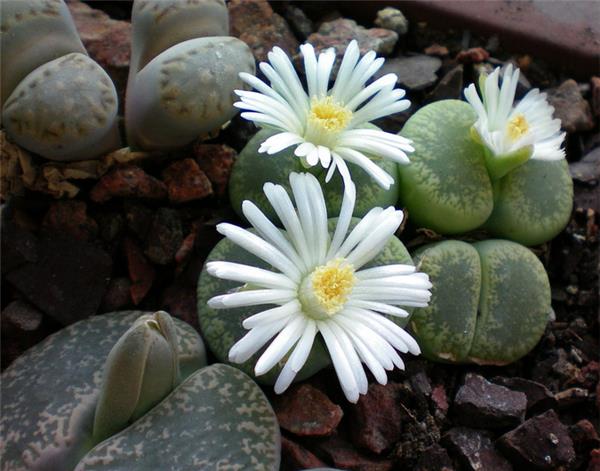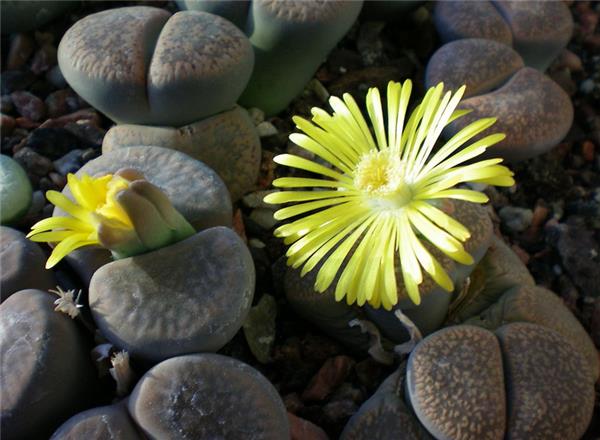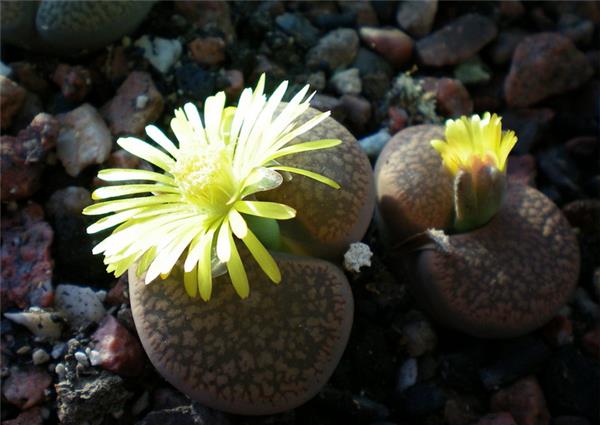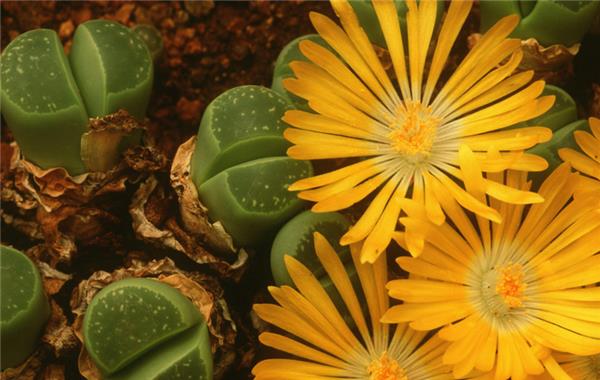How to sow stone flowers
Stone flowers are unique in shape and colorful. Small succulent plants like Yuhua stone have become very popular ornamental plants, so how to sow stone flowers?

How to sow stone flowers
1. preparation of raw stone flower before sowing
Prepare the seed
We usually get the seeds of stone flowers directly, but if we get pods, we have to find a way to get the seeds out of them. The seed pods of stone flowers are yellowish brown, hemispherical, five-petaled, dry and hard (figure 1-2). It is not easy to get the seeds out of them. If the seed pod is broken, the seed will be mixed with seed pod debris. It's not easy to separate. In fact, there is a simple way to prepare a water cup, a pair of tweezers and some absorbent paper. Pour a little lukewarm water into the cup, put in the seed pod, and soon the seed pod opens slowly, and you can clearly see the seeds inside. At this time, as long as you use tweezers to hold the seed pod back and forth, all the seeds inside will be shaken out and left in the water, leaving only the empty seed pod. Finally, the water belt seeds are poured together on the absorbent paper, and after absorbing the excess water on the seeds, the seeds with high purity are obtained. This method imitates the habits of stone flowers in their place of origin. Whenever the rainy season comes when rain falls on the pods of stone flowers, the pods will open and prepare to release the seeds, and if raindrops fall on the pods, they will bring out some of the seeds.
Prepare the matrix
There are many kinds of substrates on the market, such as red jade soil, deer marsh soil, peat, frogstone, as well as river sand, cinder and so on. Because the seeds of stone flowers are very small, the matrix must be screened, the powder and oversized particles must be removed, and a matrix of about 1 mm is left for sowing. Mix the screened matrix in a certain proportion (there are a variety of ways, you can slowly explore in practice), mix well and set aside for use. Flowerpots have no strict requirements, as long as they are easy to operate, they can be of any size.
Disinfection
No matter it is the seed or the substrate, it should be strictly sterilized before use. There are many methods of disinfection, but there are no more than two categories, physical disinfection and chemical disinfection. Physical disinfection includes cleaning, exposure, high temperature, high pressure, etc.; chemical disinfection is the use of chemicals, mainly pesticides and fungicides. Sun exposure and drug treatment are more convenient and practical.

2. Sowing seeds
time
As long as the temperature is guaranteed, stone flowers can be sown in four seasons, but spring and autumn are the best.
Loading soil
First put a screen at the bottom of the flowerpot, and then put some sifted remaining large particles to prevent stagnant water. Then fill the prepared substrate with the flowerpot, squat a few times to make the matrix tight, and keep the distance between the matrix and the flowerpot at a distance of 1 centimeter, then pour water thoroughly and set aside.
Sowing seeds
The seeds of stone flowers are small and are usually sown. Sow as evenly as possible and don't let the seeds pile up. Sprinkle 150-200 grains in the flowerpot of 10x10 rice, not too much. Too many seedlings are dense, affecting ventilation and light transmission, but also compete with each other for water and fertilizer, resulting in inconsistent growth, size differentiation, deformity, and even death. On the other hand, if there is too little, the dry-wet cycle of the substrate is slow, which can easily lead to rotten roots, so it is important to choose a flowerpot of the right size. After sowing, a thin layer of vermiculite or river sand is sprinkled on the surface to prevent seedling lodging and effectively prevent the growth of moss and green algae. Finally, spray water again so that the seeds are in full contact with the substrate. After sowing, cover the basin mouth with glass or film and place it at a temperature of 22-26 ℃, waiting for germination. No more watering is needed here.
Emergence of seedlings
If the temperature is right, the seeds will germinate 3-7 days after sowing. You will see green seedlings on the surface. Although they look a little sparse, they will soon be full of flowerpots. At this time, put the flowerpot where there is scattered light, so that the seedlings receive light. After a few days, after most of the seedlings grow, the mulch should be gradually uncovered to increase ventilation and light.

3. Management of raw stone flower after sowing
Topdressing
Topdressing can be started one month after emergence, mainly nitrogen fertilizer and potassium fertilizer, applied with water every 15-20 days, the concentration is 1500 times, not too strong, in line with the principle of thin fertilizer application.
Prevention of diseases and insect pests
Stone flower diseases and insect pests are relatively few, mainly rot disease and root pink scale. Rot can be prevented by water control. At present, there is no good way to prevent the root pink scale, if there is a root powder scale, you can do re-root treatment after it appears.
Molting period nursing
After 3 months of growth, the seedling is about to molt for the first time. At this time, the water should be cut off so that the water in the old skin can be fully absorbed by the new leaves. After this molting, the small stone has some appearance, but the opening in the middle is a little smaller. After a year, varieties and patterns can be clearly distinguished.
Transplanting seedlings
There is no certain time to move seedlings, when the seedlings grow a little crowded, it is necessary to move seedlings. It is suggested that the seedling transfer should be carried out in autumn. When moving seedlings, the roots should be trimmed, old roots, dead roots and roots of pink scale should be removed, and then the wound should be coated with fungicides such as carbendazim. Replant the wound when it is dry. When planting, it is necessary to set aside a certain growth space, which can be maintained normally after 1 week.

4. key points for the maintenance of raw stone flowers.
Humidity management
Stone flowers like a drier air environment, overcast and rainy days last too long, vulnerable to bacteria infection. For fear of rain, keep the leaves dry at night. The optimum relative humidity of the air is 40-60%.
Temperature management
The optimum growth temperature of stone flower is 15 ℃ ~ 25 ℃. It is afraid of high temperature and muggy heat, and goes into dormancy when the summer temperature is above 33 ℃. Avoid cold frost, the overwintering temperature needs to be kept above 10 ℃, and when the winter temperature drops below 7 ℃, it will also enter a dormant state. If the ambient temperature is close to 4 ℃, it will die of frostbite.
Fertilizer and water management
Stone flowers have strong drought tolerance and can grow under dry conditions, but this does not mean that they are not watered or fertilized; their roots are afraid of water stains, and if there is water in the flowerpot, or if they are watered and fertilized too frequently, it is easy to cause rotting roots. The principle of watering it is "dry and wet, dry and thoroughly dry, not dry, water thoroughly", and avoid wetting the plant during the day when watering.
Pest management
Stone flowers mainly occur leaf spot disease and leaf rot, which can be sprayed with 65% zinc wettable powder 600 times. Insect pests are harmful to ants and root-knot nematodes. Soil exchange method is used to reduce nematode damage. To prevent ants, you can use a set of pots for waterproof maintenance, so that ants can not climb to the tender and juicy spherical leaves.
Transplanting seedlings
There is no certain time to move seedlings, when the seedlings grow a little crowded, it is necessary to move seedlings. It is suggested that the seedling transfer should be carried out in autumn. When moving seedlings, the roots should be trimmed, old roots, dead roots and roots of pink scale should be removed, and then the wound should be coated with fungicides such as carbendazim. Replant the wound when it is dry. When planting, it is necessary to set aside a certain growth space, which can be maintained normally after 1 week.

4. key points for the maintenance of raw stone flowers.
Humidity management
Stone flowers like a drier air environment, overcast and rainy days last too long, vulnerable to bacteria infection. For fear of rain, keep the leaves dry at night. The optimum relative humidity of the air is 40-60%.
Temperature management
The optimum growth temperature of stone flower is 15 ℃ ~ 25 ℃. It is afraid of high temperature and muggy heat, and goes into dormancy when the summer temperature is above 33 ℃. Avoid cold frost, the overwintering temperature needs to be kept above 10 ℃, and when the winter temperature drops below 7 ℃, it will also enter a dormant state. If the ambient temperature is close to 4 ℃, it will die of frostbite.
Fertilizer and water management
Stone flowers have strong drought tolerance and can grow under dry conditions, but this does not mean that they are not watered or fertilized; their roots are afraid of water stains, and if there is water in the flowerpot, or if they are watered and fertilized too frequently, it is easy to cause rotting roots. The principle of watering it is "dry and wet, dry and thoroughly dry, not dry, water thoroughly", and avoid wetting the plant during the day when watering.
Pest management
Stone flowers mainly occur leaf spot disease and leaf rot, which can be sprayed with 65% zinc wettable powder 600 times. Insect pests are harmful to ants and root-knot nematodes. Soil exchange method is used to reduce nematode damage. To prevent ants, you can use a set of pots for waterproof maintenance, so that ants can not climb to the tender and juicy spherical leaves.
Related
- Wuhan Hospital Iron Tree Blooming Result Was Instantly Frightened by the Gardener Master
- Which variety of camellia is the most fragrant and best? Which one do you like best?
- What is the small blue coat, the breeding methods and matters needing attention of the succulent plant
- Dormancy time and maintenance management of succulent plants during dormancy
- Minas succulent how to raise, Minas succulent plant pictures
- What are the varieties of winter succulent plants
- How to raise succulent plants in twelve rolls? let's take a look at some experience of breeding twelve rolls.
- Attention should be paid to water control for succulent plants during dormant period (winter and summer)
- Watering experience of twelve rolls of succulent plants
- Techniques for fertilizing succulent plants. An article will let you know how to fertilize succulent plants.



